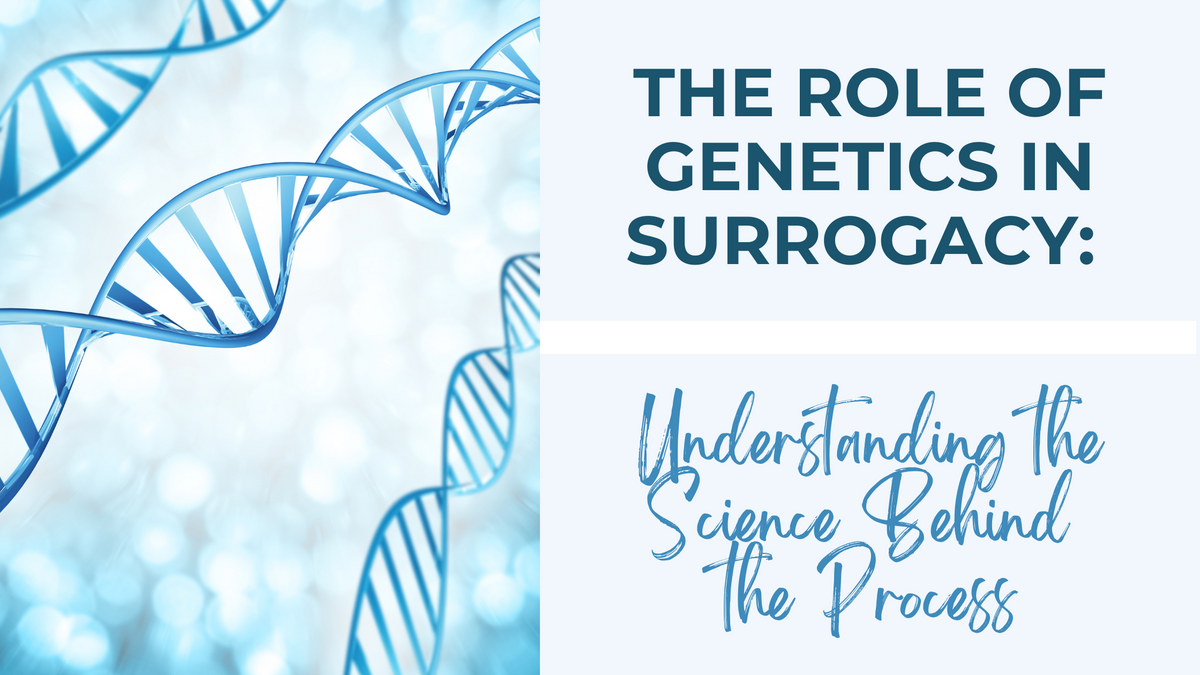Surrogacy is a complex process involving medical, legal, and emotional aspects, but at the heart of it lies a fascinating interplay of science and genetics. Understanding how genetics come into play during surrogacy provides insight into the embryo creation process and the genetic relationship between the surrogate and the baby. This post delves into the role of genetics in surrogacy and sheds light on the scientific foundations of this remarkable journey.
TAKE THE SURROGACY QUIZ CHAT WITH A SURROGATE
How Embryos Are Created in Surrogacy
In surrogacy, the embryo is created using in vitro fertilization (IVF), a process where eggs are fertilized with sperm outside the body in a clinical laboratory setting. Here’s how it typically works:
Egg and Sperm Collection: The eggs are retrieved from the intended mother(s) or an egg donor, while sperm is collected from the intended father(s) or a sperm donor. These genetic materials serve as the foundation for creating the embryo.
Fertilization: The collected eggs and sperm are combined in a laboratory under controlled conditions, allowing fertilization to occur. Sometimes, a technique called intracytoplasmic sperm injection (ICSI) is used to inject a single sperm directly into an egg, increasing the chances of successful fertilization.
Embryo Cultivation: Once fertilized, the embryos are cultured in the lab for several days. At this stage, embryologists monitor their development, selecting the healthiest embryo(s) for transfer. Preimplantation genetic testing (PGT) may be performed to screen for genetic abnormalities.
Embryo Transfer to the Surrogate: The selected embryo is transferred into the surrogate's uterus, where it hopefully implants and leads to a successful pregnancy. This transfer marks the start of the surrogate's gestational journey, carrying a baby that is genetically related to the intended parents or donors.
The Genetic Connection in Surrogacy
A crucial point to understand in surrogacy is that a gestational surrogate does not contribute her genetic material to the baby. The genetic makeup of the child comes entirely from the egg and sperm used to create the embryo. This type of surrogacy is known as gestational surrogacy, the most common form practiced today.
- Gestational Surrogacy: In this arrangement, the surrogate, often called a gestational carrier, carries the pregnancy but has no genetic link to the child. The embryo is created using the intended parents' genetic material or that of donors, ensuring the genetic heritage is aligned with the intended family’s wishes.
- Traditional Surrogacy: In rare cases, traditional surrogacy may be used, where the surrogate's own egg is fertilized with the intended father's sperm. This creates a genetic connection between the surrogate and the child. However, this form of surrogacy is much less common due to the legal and emotional complexities it can introduce.
Genetics and Surrogacy: Key Considerations
The role of genetics in surrogacy extends beyond just creating the embryo. Here are some important factors to keep in mind:
Genetic Testing and Screening:
- Intended parents often choose genetic testing to ensure the embryo is free of certain genetic disorders before the embryo transfer. Testing like PGT can detect chromosomal abnormalities, reducing the risk of genetic conditions.
- Genetic screening of egg and sperm donors is also common, ensuring that the donor does not carry any heritable conditions that could affect the child.
Epigenetics and the Surrogate's Influence:
- While the surrogate does not contribute DNA, some research suggests that the surrogate’s environment and biology can have subtle effects on the developing fetus through epigenetic mechanisms. These influences may impact gene expression, potentially affecting the child’s health and development.
- The surrogate’s lifestyle, diet, and overall health during pregnancy still play an essential role in shaping the baby’s prenatal environment, emphasizing the importance of a supportive and healthy gestational journey.
Legal and Ethical Considerations:
- Legal frameworks often emphasize the genetic relationship between the intended parents and the child, which can be pivotal in establishing legal parenthood. The absence of a genetic link between the surrogate and the baby typically simplifies the legal process.
- Ethical considerations surrounding genetic testing, embryo selection, and the use of donor gametes are essential discussions in the surrogacy process, ensuring that the rights and preferences of all parties involved are respected.
TAKE THE SURROGACY QUIZ CHAT WITH A SURROGATE
The Science Behind Surrogacy: Bridging Genetics and Parenthood
Surrogacy harnesses cutting-edge scientific advancements to assist individuals and couples in building families, often overcoming significant biological hurdles. The genetic aspect allows intended parents to pass on their genetic legacy, while the surrogate fulfills the vital role of nurturing the developing baby.
Through IVF and surrogacy, family building has become more inclusive, providing options for those facing infertility, same-sex couples, and individuals with medical conditions that prevent traditional pregnancy. The genetic connection created through these methods can be a profound aspect of surrogacy, offering intended parents the opportunity to have a biological child even when carrying the pregnancy themselves is not possible.
Conclusion
Surrogacy embodies the union of genetics, science, and a surrogate’s generosity, allowing intended parents to realize their dreams of parenthood. As science continues to evolve, the possibilities for helping families grow through surrogacy will undoubtedly expand, offering new hope and options for those on the journey to parenthood.

